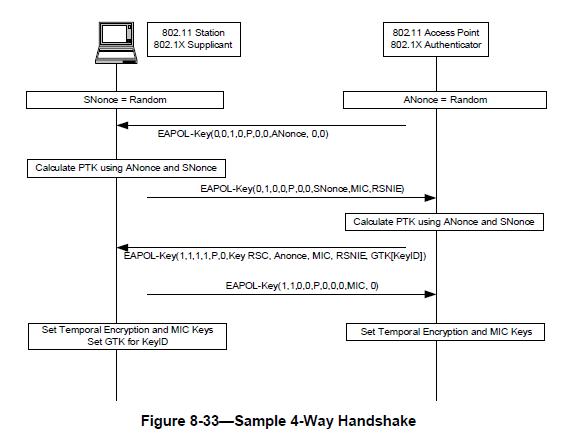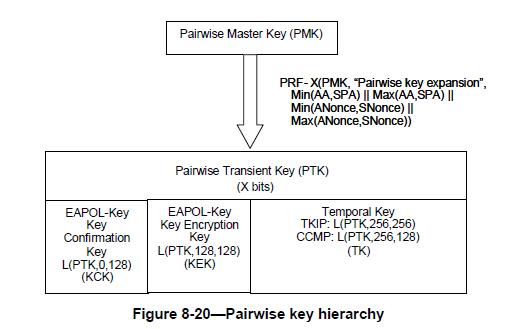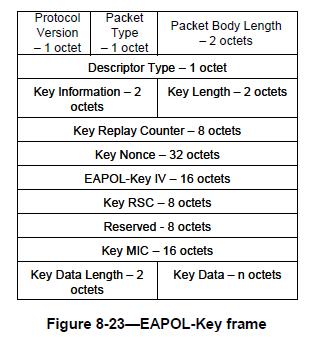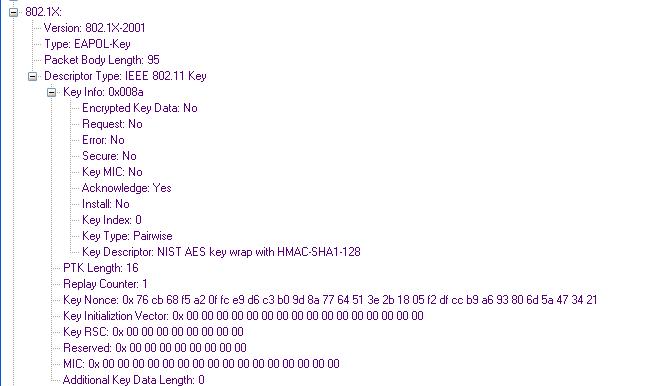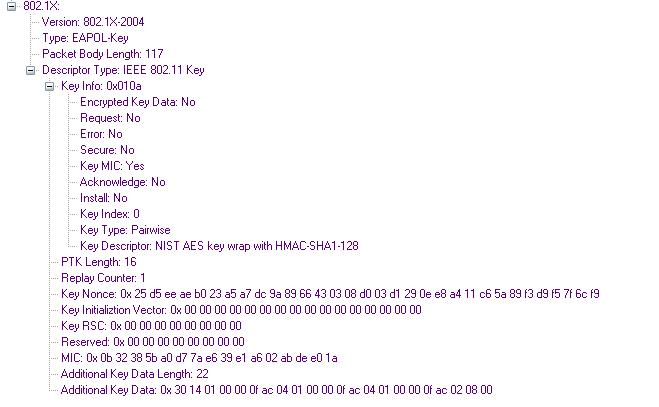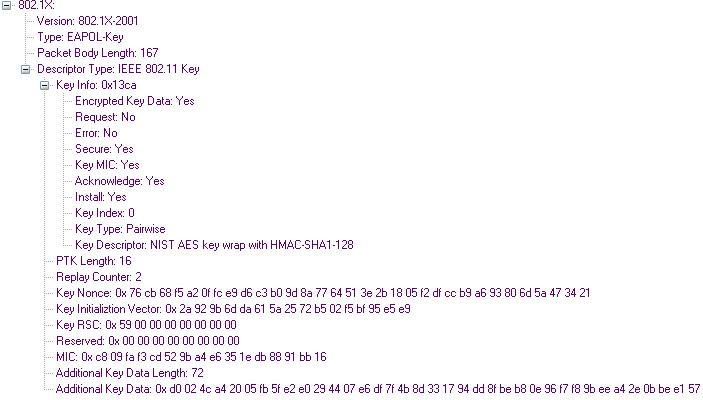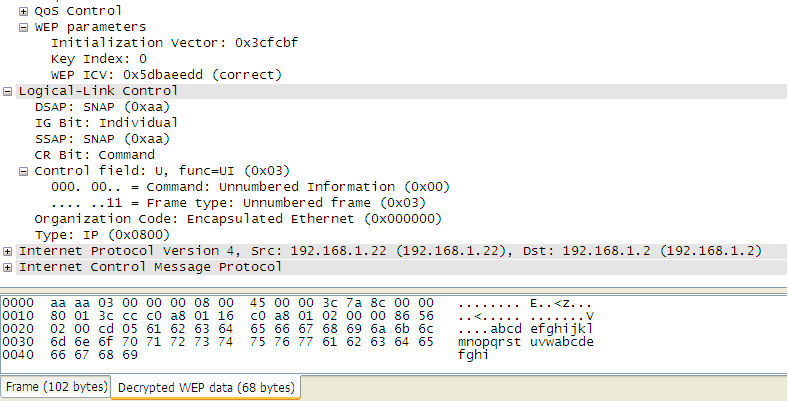LTEye: LTE Radio Analytics Made Easy and Accessible
分类: WiFi
SpotFi: Decimeter Level Localization Using WiFi
SpotFi: Decimeter Level Localization Using WiFi
继续阅读SpotFi: Decimeter Level Localization Using WiFi
802.11 Four-way handshake Messages
1. 4-way handshake sequence
2. Key Heirarchy
The EAPOL encryption key is the middle 128 bits of the PTK value.
And the first 128 bits of the PTK (KCK), is used in the computation(and validation) of the EAPOL frame MIC field value (4way handshake Message 1/2).
3. EAPOL Frame format
4 Key Data Format
Key data may be zero or more InformationElement(s) (such as the RSN information element), and zero or more key dataencapsulation(s) (KDEs) (such as GTK(s)).
4.1 RSN Information
4.2 GTK
If theEncrypted Key Data subfield (of the Key Information field) is set, the entireKey Data field shall be encrypted. If the Key Data field uses the NIST AES keywrap, then the Key Data field shall be padded before encrypting if the key datalength is less than 16 octets or if it is not a multiple of 8. The paddingconsists of appending a single octet 0xdd followed by zero or more 0x00 octets.When processing a received EAPOL-Key message, the receiver shall ignore thistrailing padding. Key Data fields that are encrypted but do not containthe GroupKey or STAKey KDE, shall be accepted.
If the GroupKey or STAKey KDE is included in the Key Data field but theKey data field is not encrypted the EAPOL-Key frames shall be ignored.
5. Sample 4-way Handshake
5.1 Message 1
The Authenticator sends an EAPOL-Key frame containing an ANonce.
Key data is zero.
5.2 Message 2
The Supplicant derives a PTK from ANonce and SNonce.
The Supplicant sends an EAPOL-Key frame containing SNonce, the RSN information element
from the Association Request frame and a MIC.
MIC is the KCK (The first 128 bits in the PTK).
Key data is RSN Information.
802.1X authentication, CCMP pairwise dna group cipher suites.
5.3 Message 3
The Authenticator derives PTK from ANonce and SNonce and validates the MIC in the EAPOL Key frame
The Authenticator sends an EAPOL-Key frame containing ANonce, the RSN from its Beacon or Probe
Response messages, MIC whether to install the temporal keys, and the encapsulated GTK
Should the MIC data be same with the one in Message 2 ?!
Key data is RSN Information + GTK, and the data is encapsulated by using of the AES algrithm with the KEK(The middle 128 bits in PTK).
5.4 Message 4
To be added.
原始链接 http://blog.csdn.net/stevenliyong/article/details/6599528
在VC中编译和使用OpenSSL
在编译OpenSSL前,需要正确安装Perl,因为在编译OpenSSL时需要使用到该程序。
下载最新版本的Perl:http://downloads.activestate.com/ActivePerl/releases/5.20.1.2000/ActivePerl-5.20.1.2000-MSWin32-x64-298557.msi。然后安装之。
Windows 一定要使用 ActivePerl 主要是由于换行跟Linux ,Unix 的不同,如果使用其他的Perl生成的MakeFile 文件,会导致NMake无法正常的编译。
另外,一定要确保ActivePerl在系统的PATH 环境变量中在最前面,并且在命令行中执行 PATH命令的输出是跟环境变量中是一致的,Windows中有时候会发生刚刚添加的环境变量不能及时更新到命令行界面的问题,即使是你已经重新打开新的命令行窗口了。
下载最新版本的OpenSSL:http://www.openssl.org/source/openssl-1.0.1j.tar.gz
一定要使用最新的OpenSSL,早期的版本有Heartbleed的BUG,另外一定要是新下载并且刚刚解压缩出来的,没有修改过的文件,有时候,某些不经意的修改会导致编译不成功。
然后将源码释放的c:\openssl-1.0.1j目录中。
进入openssl源码目录。
以下为参照该目录下的文件INSTALL.W32的执行过程:
运行configure:
创建Makefile文件:
此处建议执行 do_ms ,有时候执行do_nasm会不正常,尽管文档中说执行 do_nasm
编译动态库:
编译静态库:
测试动态库:
测试静态库:
安装动态库:
安装静态库:
清除上次动态库的编译,以便重新编译:
清除上次静态库的编译,以便重新编译:
安全协议系列(三)----CCMP与WPA-PSK
本节讨论 CCM 在 WiFi 中的实际应用 -- CCMP 协议
根据 RFC 3610,完成 CCMP 报文的加解密,需要提供:分组密钥(K)、随机数(Nonce)、附加认证数据(AAD),这三个参数从哪里来?
另外, 作为处理对象的 CCMP 报文又来自哪里? 正常是通过抓包获取,但无线报文比普通的有线(以太)报文抓取相对麻烦点
幸运的是,万能的 Internet 已经给我们准备好了,在 Wireshark 网站 -- wiki.wireshark.org -- 中有个网页链接
主流协议的报文都被世界各地的网友抓取并上传到链接指向的页面上
进入页面,下载其中一个叫 wpa-Induction.cap (Wireshark 原始地址点击这里)的抓包文件,该文件将作为后续的解密报文
至于分组密钥 K,它与 STA 如何接入 WiFi 网络有关,具体而言
如果 STA 是通过 WPA-PSK/WPA2-PSK 模式(这是家用无线路由器中使用最多的模式)接入,则 K 来源于配置此模式时输入的密码(后面记为 PSK)
如果 STA 是通过 WPA-Enterprise/WPA2-Enterprise 模式接入,则 K 来自 802.1X 认证过程中协商出来的密钥(后续会单独讨论 802.1X 认证)
这两种模式下,STA/AP 双方最终都会得到名为 PMK 的密钥
PMK 的作用类似一个密钥种子,它衍生出(更为准确说是协商出)密钥 PTK(其中就包括分组密钥 K)
就文件 wpa-Induction.cap 而言,它抓取的是 WPA-PSK 模式下 STA 与 AP 的交互报文,AP 的密码(PSK)为 Induction
本节讨论 WPA-PSK 模式下:无线网络密码(PSK) --> PMK --> PTK --> K 的具体变化情况
在无线路由器上配置过 WPA-PSK 模式的网友知道,配置时除了要输入 PSK,还要指定无线网络名(标准名为 SSID)
SSID 有两个作用:标识 AP 自己的名称(与其他 AP 区分出来),另一个就是参与 PMK 的构造
构造过程遵循 PKCS #5 v2.0 中的 PBKDF2 标准,简言之,我们可以认为 PMK = PBKDF2(PSK, SSID)
wpa-Induction.cap 中的 SSID 又是多少?这需要查看类型为 Beacon 的报文
其中有个字段解析为 SSID parameter set: Coherer,即 SSID 名称为 Coherer
这里我们看到,一旦输入的 PSK 和 SSID 固定,PMK 就不再变化,这带来了一定的安全性问题
因为知道 PSK 的 STA 可以通过抓取四次握手报文,嗅探别的 STA 与 AP 之间的流量(见后面详细说明)
在 WPA-Enterprise/WPA2-Enterprise 模式中,PMK 是动态生成的,避免了上述担心
脚本 PBKDF2.pl 是生成 PMK 过程的代码实现,下面是其内容及执行结果
C:\>perl PBKDF2.pl Induction Coherer
输出如下:
Salt = SSID = Coherer
Password = Induction
WPA-PSK:PMK = A288FCF0CAAACDA9A9F58633FF35E8992A01D9C10BA5E02EFDF8CB5D730CE7BC
前已述及,PMK 会协商出 PTK,这个协商过程就是著名的 EAPOL-Key 四次握手
具体而言,四次握手的前两个报文(分别由 STA/AP 发出)各自包括了一串名为 WPA Key Nonce 的随机数(分别记为 ANonce/SNonce)
在 wpa-Induction.cap 中,EAPOL-Key 四次握手报文分别为 #87 #89 #92 #94,其中
#87 报文包含 WPA Key Nonce: 3e8e967dacd960324cac5b6aa721235bf57b949771c867989f49d04ed47c6933 -- ANonce
#89 报文包含 WPA Key Nonce: cdf405ceb9d889ef3dec42609828fae546b7add7baecbb1a394eac5214b1d386 -- SNonce
光有这两个随机数还不够,IEEE 802.11i 中还规定,STA 和 AP 的无线 MAC 地址(分别记为 AA/SPA)也要参与 PTK 的生成
最终生成 PTK 需要五个参数:PMK、AA、SPA、ANonce、SNonce
脚本 PMK2PTK.pl 对上述过程进行了实现,下面是其内容及执行结果
C:\>perl PMK2PTK.pl a288fcf0caaacda9a9f58633ff35e8992a01d9c10ba5e02efdf8cb5d730ce7bc 000c4182b255 000d9382363a
3e8e967dacd960324cac5b6aa721235bf57b949771c867989f49d04ed47c6933
cdf405ceb9d889ef3dec42609828fae546b7add7baecbb1a394eac5214b1d386
上面命令行实际在一行内输入,只处为折行显示
输出如下:
EAPOL-Key Confirm Key b1cd792716762903f723424cd7d16511
EAPOL-Key Encrypt Key 82a644133bfa4e0b75d96d2308358433
(TKIP|CCMP) Temporal Key 15798d511beae0028313c8ab32f12c7e
TKIP MIC Key(for Authenticator Tx) cb71c893482669da
TKIP MIC Key(for Supplicant Tx) af0e9223fe1c0aed
从输出结果中看到,PTK 并不是一个单独的密钥,而是分成若干部分
其中 EAPOL-Key Confirm Key 和 EAPOL-Key Encrypt Key 仅用于 EAPOL-Key 的四次握手(对握手报文起加密和认证作用)
第三行 (TKIP|CCMP) Temporal Key 参与报文的加解密,在我们讨论的上下文中,就是 CCM 中的分组密钥 K
最后二行 TKIP MIC Key(...) 仅适用于 TKIP 协议,与 CCMP 协议无关
下面以报文 #99 为例,剖析 CCMP 的具体操作,报文内容如下
08 41 2c 00 00 0c 41 82 b2 55 00 0d 93 82 36 3a -- IEEE 802.11 Data 报文头
ff ff ff ff ff ff b0 01 01 00 00 20 00 00 00 00
7e cc f6 0a c1 dd ff b0 47 96 c3 0b a1 9c 92 c6 -- 此行开始共 336 字节(共 21 行)为密文部分
6f 4d 1c e7 27 08 c2 95 cf 58 19 45 8c 18 d5 1f 提取为文件 wpa-Induction-cipher.txt
64 56 7a 7c c5 ff 85 e7 a6 8b 23 8a 33 5e 44 44
f7 de 0c 5e ef 72 1d 9f db 0d 51 44 03 d1 c9 06
46 15 23 3e fc e2 4b 41 6d 53 8c 88 84 5e 46 0d
29 63 0e da 72 97 fd db b5 66 ac 0a 05 f9 21 1f
bf 24 39 9a 15 a9 15 11 04 39 bd 0c 0c 51 0a 08
4a 88 90 50 01 fc 64 cc 9a 4f ca d2 51 d6 e0 f1
55 00 b7 13 fb 42 c2 44 60 58 2a 68 d0 a5 b9 9c
80 8e 01 2c 20 0a c5 27 b0 eb 32 0f 75 7d 60 ea
01 fa 79 f6 5c 2f c3 55 66 90 62 d9 25 e3 e4 4c
02 91 c1 a7 36 d5 0f 0b 8c 6c 68 de 9e 53 6e d9
7f eb 43 93 82 80 4b 73 92 3a 61 7f cc ef 37 60
cf 65 98 f7 7e 39 b9 90 a6 d1 67 ab 5c a6 a9 57
76 38 fe a8 34 2c 97 ab d5 54 f5 6f ea 48 eb 48
be 52 df c8 27 66 7b 1c 09 08 78 58 b9 96 9a 74
10 2d 53 e3 7d 35 2e e4 62 44 84 3d 02 f5 1b 04
43 64 cb 26 33 fd 2e 8c 16 0a 21 31 24 56 e5 74
74 89 33 e0 d8 49 5b e8 23 97 d8 9c b7 39 f7 ab
a0 e8 44 c2 b8 dc 3a 3d 57 d1 a7 b0 7e a9 ff 97
a3 d7 17 ff 02 83 0b 58 2c a8 94 27 -- 本行中前 8 字节为认证字段部分,后 4 字节为 FCS
CCMP 协议规定:认证字段长度 M = 8
现在已经知道分组密钥 K = 15798d511beae0028313c8ab32f12c7e
另两个参数 AAD/Nonce,它们在 IEEE 802.11i 有详细定义,这里直接给出结果
AAD = l(a) || a,构造比较复杂,我们估且认为它是下列字段的组合(实际上做了一些修正,感兴趣可参考标准)
l(a) || Frame Control || Address 1 || Address 2 || Address 3 || Sequence Control || Address 4 || Qos Control
长度 2 2 6 6 6 2 6 2
其中最后两个字段 Address 4、Qos Control 为可选字段, 所以 AAD 长度范围是 24-32 字节
将 AAD 以 16 字节为单位分组,得到 B_1、B_2 两个附加认证分组,其中 B_2 可能要用 0 填充
在本例中,实际的 AAD 内容为(最后两个字段 Address 4、Qos Control 不存在,末尾填充 0)
00 16 08 41 00 0c 41 82 b2 55 00 0d 93 82 36 3a ff ff ff ff ff ff 00 00 00 00 00 00 00 00 00 00
l(a) Fc Address 1 Address 2 Address 3 此处开始用 0 填充
生成 AAD 分组文件
C:\>perl -e "binmode STDOUT; print pack('H*','00160841000c4182b255000d9382363affffffffffff00000000000000000000')" > aad.txt
Nonce 相对简单,其长度 = 15 - L = 15 - 2 = 13,格式为
Nonce = Priority Octet || A2 || PN
= 00 || 00 0d 93 82 36 3a || 00 00 00 00 00 01
= 00 00 0d 93 82 36 3a 00 00 00 00 00 01
B_0 = Flags || Nonce || l(m)
= 59 || 00 00 0d 93 82 36 3a 00 00 00 00 00 01 || 01 50 -- 0x0150 = 336
= 59 00 00 0d 93 82 36 3a 00 00 00 00 00 01 01 50
生成 B_0 分组文件
C:\>perl -e "binmode STDOUT; print pack('H*','5900000d9382363a0000000000010150')" > b_0.txt
计算 A_i ...
A_0 = 01 00 00 0d 93 82 36 3a 00 00 00 00 00 01 00 00
A_1 = 01 00 00 0d 93 82 36 3a 00 00 00 00 00 01 00 01
生成 A_1 || A_2 || ... 分组文件
C:\>perl -e "binmode STDOUT; for(
# 循环 21 次,因为 21 * 16 = 336,索引为何从 1 开始,参见上节
计算密钥流 E( K, A_1 || A_2 || ... )
C:\>openssl enc -aes-128-ecb -K 15798d511beae0028313c8ab32f12c7e -iv 0 -nopad -in a_i.txt > enc_key.txt
密文 与 加密密钥 异或,得到明文
C:\>perl xor_file.pl wpa-Induction-cipher.txt enc_key.txt > wpa-Induction-plain.txt
明文内容是什么呢?我们对下答案,看看 Wireshark 自身的 CCMP 解密结果,如下图
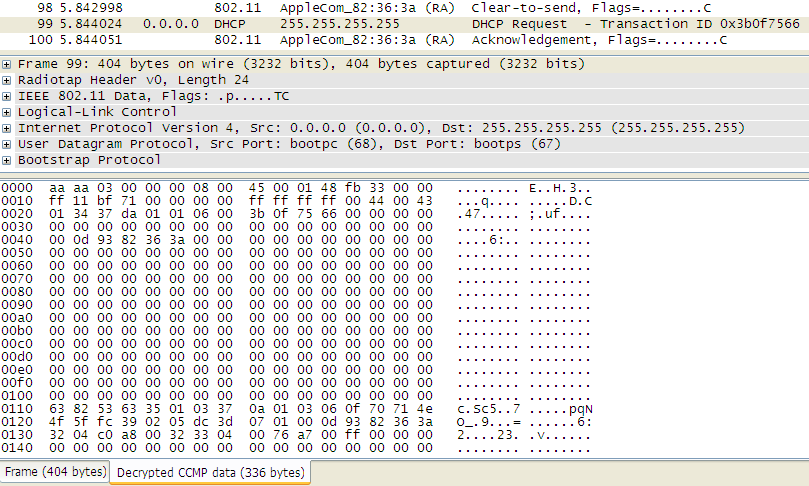
原来是 DHCP Request 报文,这也说明 WiFi 安全属于二层安全范畴
仔细对比明文 wpa-Induction-plain.txt 的内容,完全符合
仅仅满足数据的机密性还是不够的,如何判断报文是否被篡改过?
CCMP 是通过附在密文后的 8 字节认证字段(红色显示部分)来解决的,下面按照 RFC 3610 中的规定进行验证
已知 A_0 = 01 00 00 0d 93 82 36 3a 00 00 00 00 00 01 00 00
生成 A_0 分组文件
C:\>perl -e "binmode STDOUT; print pack('H*','0100000d9382363a0000000000010000')" > a_0.txt
生成数据校验密钥 E(K, A_0)
C:\>openssl enc -aes-128-ecb -K 15798d511beae0028313c8ab32f12c7e -iv 0 -nopad -in a_0.txt > mac_key.txt
C:\>od -An -tx1 mac_key.txt
37 ef 73 a5 87 be 43 61 92 b3 6e ed c2 01 a3 49 -- 取前 8 字节 37 ef 73 a5 87 be 43 61
数据校验密钥 与 认证字段 异或,得到 X_n+1(即 CBC-MAC)的期望值
C:\>perl xor.pl 37ef73a587be4361 a3d717ff02830b58
结果为 XOR = 9438645A853D4839
而真实的 CBC-MAC 由密钥 K 对 -- B_0 || AAD分组 || WiFi明文分组(wpa-Induction-plain.txt) -- 进行 CBC 加密得到
合并 B_0 || AAD分组 || WiFi明文分组
C:\>perl -pe "BEGIN{binmode STDOUT;}" b_0.txt aad.txt wpa-Induction-plain.txt > b.txt
AES 加密计算 CBC-MAC
C:\>perl AES-CBC.pl encrypt 15798d511beae0028313c8ab32f12c7e 00000000000000000000000000000000 b.txt > cbc-mac.txt
文件 cbc-mac.txt 的最后一个分组为
94 38 64 5A 85 3D 48 39 5B 35 A9 89 E6 47 A3 3B
其前 8 字节 9438645A853D4839 与 期望值 相同,校验成功,说明报文未被篡改
再看报文最后一个字段 FCS(蓝色显示部分),在 CCMP 中也是起校验作用
不过校验范围为除 FCS 外的整个报文,即:报文头 || 密文 || 认证字段,不像 WEP 报文中是针对明文校验
同样也可以利用 perl 自带的 crc32.bat 脚本进行验证
安全协议系列(二)----CCM与CCMP
CCMP(CTR with CBC-MAC Protocol) 是 IEEE 802.11i 中推出使用基于 AES 的 CCM 模式的安全加密协议。
与原来脆弱的 WEP 算法及临时补救措施 TKIP 协议相比,它具有更好的安全性,在 WiFi 中得到广泛的应用。
CCM(Counter with CBC-MAC) 定义在 RFC 3610 中,它是一种使用分组算法(例如 AES)进行数据认证和加密的通用模式。
下面是 RFC 3610 中重要部分的中文注释和说明
1. Introduction
Counter with CBC-MAC (CCM) is a generic authenticated encryption block cipher mode.
CCM 对明文数据(记为 m,其长度记为 l(m))进行分组加密和认证,处理结果同时包括密文和认证字段
CCM is defined for use with 128-bit block ciphers, such as the Advanced Encryption Standard (AES).
专门用于 block size 为 128 位的分组加密算法,如 AES
2. CCM Mode Specification
For the generic CCM mode there are two parameter choices.
CCM 有 2 个参数选项
The first choice is M, the size of the authentication field.
Valid values are 4, 6, 8, 10, 12, 14, and 16 octets.
第 1 个选项: M -- 输出的认证字段长度(单位:字节),取值范围:4, 6, 8, 10, 12, 14, and 16
The second choice is L, the size of the length field.
Valid values of L range between 2 octets and 8 octets.
第 2 个选项: L -- 表示 l(m) 值的字节数( l(m) < 2^(8L) ),取值范围:2-8
将 M 和 L 转换为 M' 和 L'(以便容纳在一个字节中),转换关系如下
Name Description Size Encoding
---- ---------------------------------------- ------ --------
M' Number of octets in authentication field 3 bits (M-2)/2
L' Number of octets in length field 3 bits L-1
CCMP 协议规定:M = 8 L = 2, 即 m 最长为 65535 字节,认证字段为 8 字节
2.1. Inputs -- 认证加密 m 所需的参数
1. An encryption key K suitable for the block cipher.
分组密钥 K
2. A nonce N of 15-L octets. Within the scope of any encryption key K,
the nonce value MUST be unique.
随机数 N,15-L 字节长,在 K 的生命过程中要确保 N 不被重复使用
3. The message m, consisting of a string of l(m) octets where 0 <=
l(m) < 2^(8L). The length restriction ensures that l(m) can be
encoded in a field of L octets.
此段内容上面已讲得很清楚
4. Additional authenticated data a, consisting of a string of l(a)
octets where 0 <= l(a) < 2^64. This additional data is
authenticated but not encrypted, and is not included in the
output of this mode. It can be used to authenticate plaintext
packet headers, or contextual information that affects the
interpretation of the message. Users who do not wish to
authenticate additional data can provide a string of length zero.
附加认证数据 a,用于数据的完整性校验(不参与加密运算),可选
通常用于认证 报文头的明文字段 或 对消息理解有影响的上下文
The inputs are summarized as:
Name Description Size
---- ----------------------------------- -----------------------
K Block cipher key/分组加密密钥 Depends on block cipher
N Nonce/随机数 15-L octets
m Message to authenticate and encrypt l(m) octets
a Additional authenticated data/附加认证数据 l(a) octets
2.2. Authentication -- 生成认证字段
The first step is to compute the authentication field T. This is
done using CBC-MAC [MAC]. We first define a sequence of blocks B_0,
B_1, ..., B_n and then apply CBC-MAC to these blocks.
第一步计算认证字段 T,使用 CBC-MAC 算法,该算法涉及输入分组 B_0,B_1, ..., B_n
The first block B_0 is formatted as follows, where l(m) is encoded in
most-significant-byte first order:
第一个数据分组 B_0 构成如下
Octet Number Contents
------------ ---------
0 Flags 1 字节
1 ... 15-L Nonce N 15-L 字节
16-L ... 15 l(m) L 字节(L 的值见 Flags 字节)
Within the first block B_0, the Flags field is formatted as follows:
分组 B_0 中的首字节 Flags 构成如下
Bit Number Contents
---------- ----------------------
7 Reserved (always zero)
6 Adata
5 ... 3 M' (1--7) = (M-2)/2 (M:4--16)
2 ... 0 L' (1--7) = L-1 (L:2--8)
Another way say the same thing is: Flags = 64*Adata + 8*M' + L'.
B_0 构成如下
长度 1 15-L L
+----+-----+-----------+------------+
|字节 | 0 | 1 .. 15-L | 16-L .. 15 |
+----+-----+-----------+------------+
|内容 |Flags| Nonce N | m 的长度 |
+----+-----+-----------+------------+
/ \ ^
/ \ |
/ \ L -- m 的长度表示范围
/ \ (L 越大,m 可以越长)
/ Flags 展开后 \ |
+----+-+-----+-+-+-+-+-+-+ |L'(L) 决定
|位 |7| 6 |5|4|3|2|1|0| |Nonce 的长度
+----+-+-----+-+-+-+-+-+-+ |
|内容 |0|Adata| M' | L' | ---+
+----+-+-----+-+-+-+-+-+-+
The Adata bit is set to zero if l(a)=0, and set to one if l(a)>0.
如果 Bit6(Adata 位)=0,表示要生成附加认证数据 a,否则表示没有
If l(a)>0 (as indicated by the Adata field), then one or more blocks
of authentication data are added. These blocks contain l(a) and a
encoded in a reversible manner. We first construct a string that
encodes l(a).
生成附加认证数据 a,需要构造认证数据块(一个或多个),数据块编码如下
If 0 < l(a) < (2^16 - 2^8), then the length field is encoded as two
octets which contain the value l(a) in most-significant-byte first
order.
a 长度 < 65536-256,此情况比较普遍
The length encoding conventions are summarized in the following
table. Note that all fields are interpreted in most-significant-byte
first order.
First two octets Followed by Comment
----------------- ---------------- -------------------------------
0x0000 Nothing Reserved
0x0001 ... 0xFEFF Nothing For 0 < l(a) < (2^16 - 2^8)
0xFF00 ... 0xFFFD Nothing Reserved
0xFFFE 4 octets of l(a) For (2^16 - 2^8) <= l(a) < 2^32
0xFFFF 8 octets of l(a) For 2^32 <= l(a) < 2^64
The blocks encoding a are formed by concatenating this string that
encodes l(a) with a itself, and splitting the result into 16-octet
blocks, and then padding the last block with zeroes if necessary.
These blocks are appended to the first block B0.
将 l(a)||a 分成 16 字节长的分组,必要时最后一个分组添加 0x00 补齐
这些分组依次添加到 B_0 后面(记为 B_1、B_2……)
After the (optional) additional authentication blocks have been
added, we add the message blocks. The message blocks are formed by
splitting the message m into 16-octet blocks, and then padding the
last block with zeroes if necessary. If the message m consists of
the empty string, then no blocks are added in this step.
附加认证分组添加后,我们构造明文分组,将 m 分成 16 字节长的分组
必要时最后一个分组补 0 对齐(如果 m 为空串,则此步省略)
The result is a sequence of blocks B0, B1, ..., Bn. The CBC-MAC is
computed by:
最终得到 B_0||附加认证分组||明文分组,按下列公式计算 CBC-MAC
X_1 := E( K, B_0 )
X_i+1 := E( K, X_i XOR B_i ) for i=1, ..., n
T := first-M-bytes( X_n+1 ) -- T 作为 MAC 值
B_0 B_1 B_2 B_n
| | | |
| V V V
| +-->XOR +-->XOR +-->XOR
| | | | | | |
V | V | V | V
+----+ | +----+ | +----+ | +----+
K-->|加密 | | |加密| | |加密 | ... | |加密|
+----+ | +----+ | +----+ | +----+
| | | | | | |
+----+ +----+ +--> ->-+ |
| | | X_n |
V V V V
X_1 X_2 X_3 X_n+1
2.3. Encryption -- 生成密文
To encrypt the message data we use Counter (CTR) mode. We first
define the key stream blocks by:
使用 Counter (CTR) 模式加密,首先计算如下密钥流
S_i := E( K, A_i ) for i=0, 1, 2, ...
The values A_i are formatted as follows, where the Counter field i is
encoded in most-significant-byte first order:
Octet Number Contents
------------ ---------
0 Flags
1 ... 15-L Nonce N
16-L ... 15 Counter i
The Flags field is formatted as follows:
Bit Number Contents
---------- ----------------------
7 Reserved (always zero)
6 Reserved (always zero)
5 ... 3 Zero
2 ... 0 L'
Another way say the same thing is: Flags = L'.
A_i 构成如下
长度 1 15-L L
+----+-----+-----------+------------+
|字节 | 0 | 1 .. 15-L | 16-L .. 15 |
+----+-----+-----------+------------+
|内容 |Flags| Nonce N | Counter i | -- Counter i 的值能够在 L 字节内表示
+----+-----+-----------+------------+ (因为 i <= l(m))
/ \ ^
/ \ |
/ \ |
/ \ |
/ Flags 展开后 \ |
+----+-+-----+-+-+-+-+-+-+ |L'(L) 决定
|位 |7|Adata|5|4|3|2|1|0| |Nonce 的长度
+----+-+-----+-+-+-+-+-+-+ |
|内容 |0| 0 |M'=0 | L' | ---+
+----+-+-----+-+-+-+-+-+-+
|
M' 不同于 B_0(B_0 中始终不为 0)
The message is encrypted by XORing the octets of message m with the
first l(m) octets of the concatenation of S_1, S_2, S_3, ... . Note
that S_0 is not used to encrypt the message.
明文与密钥流异或,得到密文,S_0 不用于加密,但参与数据校验
A_0 A_1 A_2 A_n
| | | |
V V V V
+----+ +----+ +----+ +----+
K-->|加密 | |加密| | 加密| ... |加密|
+----+ +----+ +----+ +----+
| | | |
| |S_1 |S_2 |S_n
| | | | 密钥: S_1 | S_2 | ... | S_n
| V V V XOR
| M_1-->XOR M_2-->XOR M_n-->XOR 明文: M_1 | M_2 | ... | M_n
| | | | |
V V V V V
S_0 C_1 C_2 C_n 密文: C_1 | C_2 | ... | C_n
The authentication value U is computed by encrypting T with the key
stream block S_0 and truncating it to the desired length.
T 与 S_0 的异或结果取前 M 字节,得到认证字段
U := T XOR first-M-bytes( S_0 )
2.4. Output -- 最终输出
取前 l(m) 字节 取前 M 字节
================================= ============
S_1/E(K,A_1) | S_2/E(K,A_2) | ... || S_0/E(K,A_0)
XOR m || X_n+1
-----------------------------------------------------
= 最终输出 c
其中 X_i 计算如下
X_1 := E( K, B_0 )
X_i+1 := E( K, X_i XOR B_i ) for i=1, ..., n
8. Test Vectors -- 使用测试数据进行计算演示
=============== Packet Vector #1 ==================
AES Key = C0 C1 C2 C3 C4 C5 C6 C7 C8 C9 CA CB CC CD CE CF
Nonce = 00 00 00 03 02 01 00 A0 A1 A2 A3 A4 A5
Total packet length = 31. [Input with 8 cleartext header octets]
扣除 8 字节明文头,只有 31-8=23 字节需要处理
00 01 02 03 04 05 06 07 08 09 0A 0B 0C 0D 0E 0F
10 11 12 13 14 15 16 17 18 19 1A 1B 1C 1D 1E
明文分组
M_1 -- 08 09 0A 0B 0C 0D 0E 0F 10 11 12 13 14 15 16 17
M_2 -- 18 19 1A 1B 1C 1D 1E
以下计算数据认证字段
CBC IV in: 59 00 00 00 03 02 01 00 A0 A1 A2 A3 A4 A5 00 17 -- 实际就是 B_0
| | | |
| |<--------------- Nonce --------------->| |
| 23 字节
Flags = 0 1 0 1 1 0 0 1 (binary)
| | |---| |---|
| | | |
| | | L'=1 <--> L=2
| | M'=3 <--> M=8
| Adata=1 表示有认证字段
Reserved (always zero)
CBC IV out:EB 9D 55 47 73 09 55 AB 23 1E 0A 2D FE 4B 90 D6
验证 X_1 := E( K, B_0 )
C:\>perl -e "binmode STDOUT; print pack('H*','5900000003020100A0A1A2A3A4A50017')" > B_0.txt
C:\>openssl enc -aes-128-ecb -K C0C1C2C3C4C5C6C7C8C9CACBCCCDCECF -iv 0 -nopad -in B_0.txt > X_1.txt
C:\>od -An -tx1 -v X_1.txt
eb 9d 55 47 73 09 55 ab 23 1e 0a 2d fe 4b 90 d6
After xor: EB 95 55 46 71 0A 51 AE 25 19 0A 2D FE 4B 90 D6 [hdr]
验证 X_1 XOR B_1 -- xor.pl 源码见后面
C:\>perl xor.pl 00080001020304050607000000000000 EB9D5547730955AB231E0A2DFE4B90D6
00080001020304050607000000000000 B_1 附加认证数据(8 字节)
EB9D5547730955AB231E0A2DFE4B90D6 X_1
--------------------------------------
XOR = EB955546710A51AE25190A2DFE4B90D6
After AES: CD B6 41 1E 3C DC 9B 4F 5D 92 58 B6 9E E7 F0 91
验证 X_2 := E( K, X_1 XOR B_1 )
C:\>perl -e "binmode STDOUT; print pack('H*','EB955546710A51AE25190A2DFE4B90D6')" > X_1_XOR_B_1.txt
C:\>openssl enc -aes-128-ecb -K C0C1C2C3C4C5C6C7C8C9CACBCCCDCECF -iv 0 -nopad -in X_1_XOR_B_1.txt > X_2.txt
C:\>od -An -tx1 -v X_2.txt
cd b6 41 1e 3c dc 9b 4f 5d 92 58 b6 9e e7 f0 91
After xor: C5 BF 4B 15 30 D1 95 40 4D 83 4A A5 8A F2 E6 86 [msg]
验证 X_2 XOR B_2
C:\>perl xor.pl 08090A0B0C0D0E0F1011121314151617 CDB6411E3CDC9B4F5D9258B69EE7F091
08090A0B0C0D0E0F1011121314151617 B_2 -- 从 B_2 开始起为明文部分
CDB6411E3CDC9B4F5D9258B69EE7F091 X_2
--------------------------------------
XOR = C5BF4B1530D195404D834AA58AF2E686
After AES: 9C 38 40 5E A0 3C 1B C9 04 B5 8B 40 C7 6C A2 EB
验证 X_3 := E( K, X_2 XOR B_2 )
C:\>perl -e "binmode STDOUT; print pack('H*','C5BF4B1530D195404D834AA58AF2E686')" > X_2_XOR_B_2.txt
C:\>openssl enc -aes-128-ecb -K C0C1C2C3C4C5C6C7C8C9CACBCCCDCECF -iv 0 -nopad -in X_2_XOR_B_2.txt > X_3.txt
C:\>od -An -tx1 -v X_3.txt
9c 38 40 5e a0 3c 1b c9 04 b5 8b 40 c7 6c a2 eb
After xor: 84 21 5A 45 BC 21 05 C9 04 B5 8B 40 C7 6C A2 EB [msg]
验证 X_3 XOR B_3
C:\>perl xor.pl 18191A1B1C1D1E000000000000000000 9C38405EA03C1BC904B58B40C76CA2EB
18191A1B1C1D1E000000000000000000 B_3 -- B_3 作为明文最后一个分组,以 0 字节补齐
9C38405EA03C1BC904B58B40C76CA2EB X_3
--------------------------------------
XOR = 84215A45BC2105C904B58B40C76CA2EB
After AES: 2D C6 97 E4 11 CA 83 A8 60 C2 C4 06 CC AA 54 2F
验证 X_4 := E( K, X_3 XOR B_3 )
C:\>perl -e "binmode STDOUT; print pack('H*','84215A45BC2105C904B58B40C76CA2EB')" > X_3_XOR_B_3.txt
C:\>openssl enc -aes-128-ecb -K C0C1C2C3C4C5C6C7C8C9CACBCCCDCECF -iv 0 -nopad -in X_3_XOR_B_3.txt > X_4.txt
C:\>od -An -tx1 -v X_4.txt
2d c6 97 e4 11 ca 83 a8 60 c2 c4 06 cc aa 54 2f
CBC-MAC : 2D C6 97 E4 11 CA 83 A8 -- 取前 8 字节
以下计算密钥流
S_i := E( K, A_i ) for i=0, 1, 2, ...
A_i 是 L、Nonce、i 的函数,格式如下
01 00 00 00 03 02 01 00 A0 A1 A2 A3 A4 A5 00 00
| | | |
| |<--------------- Nonce --------------->| |
| Counter(0000、0001、0002...)
Flags = 0 0 0 0 0 0 0 1 (binary)
| | |---| |---|
| | | |
| | | L'=1 <--> L=2
| | Zero
| 相当于 Adata=0
Reserved (always zero)
CTR Start: 01 00 00 00 03 02 01 00 A0 A1 A2 A3 A4 A5 00 01 -- A_1
CTR[0001]: 50 85 9D 91 6D CB 6D DD E0 77 C2 D1 D4 EC 9F 97 -- S_1
CTR[0002]: 75 46 71 7A C6 DE 9A FF 64 0C 9C 06 DE 6D 0D 8F -- S_2
CTR[MAC ]: 3A 2E 46 C8 EC 33 A5 48 -- S_0 取前 M 字节
C:\>od -An -tx1 -v A_.txt
01 00 00 00 03 02 01 00 a0 a1 a2 a3 a4 a5 00 00 -- A_0
01 00 00 00 03 02 01 00 a0 a1 a2 a3 a4 a5 00 01 -- A_1
01 00 00 00 03 02 01 00 a0 a1 a2 a3 a4 a5 00 02 -- A_2
C:\>openssl enc -aes-128-ecb -K C0C1C2C3C4C5C6C7C8C9CACBCCCDCECF -iv 0 -nopad -in A_.txt > key.txt
C:\>od -An -tx1 -v key.txt
3a 2e 46 c8 ec 33 a5 48 56 20 54 2c 02 2c c0 7d -- S_0
50 85 9d 91 6d cb 6d dd e0 77 c2 d1 d4 ec 9f 97 -- S_1
75 46 71 7a c6 de 9a ff 64 0c 9c 06 de 6d 0d 8f -- S_2
Total packet length = 39. [Authenticated and Encrypted Output]
00 01 02 03 04 05 06 07 58 8C 97 9A 61 C6 63 D2
F0 66 D0 C2 C0 F9 89 80 6D 5F 6B 61 DA C3 84 17
E8 D1 2C FD F9 26 E0
注意
m T
----------------------------------------------================
08090A0B0C0D0E0F101112131415161718191A1B1C1D1E2DC697E411CA83A8
S_1 S_2 S_0
--------------------------------==============----------------
50859d916dcb6ddde077c2d1d4ec9f977546717ac6de9a3a2e46c8ec33a548
C:\>perl xor.pl 08090A0B0C0D0E0F101112131415161718191A1B1C1D1E2DC697E411CA83A8 50859d916dcb6ddde077c2d1d4ec9f977546717ac6de9a3a2e46c8ec33a548
08090A0B0C0D0E0F101112131415161718191A1B1C1D1E2DC697E411CA83A8
50859d916dcb6ddde077c2d1d4ec9f977546717ac6de9a3a2e46c8ec33a548
--------------------------------------------------------------------
XOR = 588C979A61C663D2F066D0C2C0F989806D5F6B61DAC38417E8D12CFDF926E0 正确
在 CCMP 中,对称密钥 K 同时对明文数据进行加密和认证,C(Confidentiality) 和 I(Integrality) 都得到了保证
而 S(Signature) 和 A(Authentication) 是否达标,则取决于对称密钥 K 的安全性
从 IEEE 802.11i 中我们知道,K 是由著名的 EAPOL-Key 四次握手衍生得到,其安全性又取决于 PMK
PMK 又来自哪里?
IEEE 802.11i 标准中有两种工作模式:PSK 和 802.1X。
在 PSK 模式中,AP 和所有 STA 预先共享同一个密钥,该共享密钥经过简单的变换得到 PMK(后面将给出公式)
原则上 AP 无法区别不同的 STA -- 排除其他方式比如 MAC 地址过滤 -- 所以做不到 A(Authentication)
因为 AP 只知道有一个掌握了预共享密钥的家伙连上我了
至于这个家伙是谁?他的预共享密钥是不是偷来的?AP 一概不知
PSK 模式下 STA 反过来也无法认证 AP,这有点类似 GSM 网络中的伪基站
在 802.1X 模式中,安全性得到了增强,认证协议为 EAP,包含的认证子协议有 EAP-TLS/EAP-TTLS/EAP-PEAP 等
上述三种子协议都采用 TLS 隧道加密,天然支持 STA 对 AP 的认证
如果是 EAP-TLS 协议,还需要部署 STA 证书,因而可以做到相互认证,在这种情况下 SCIA,安全特性一个也不少
最后附上 xor.pl 源代码
安全协议系列(一)----WEP详解
WEP加密报文如下,其加密密钥为ASCII字符串:12345
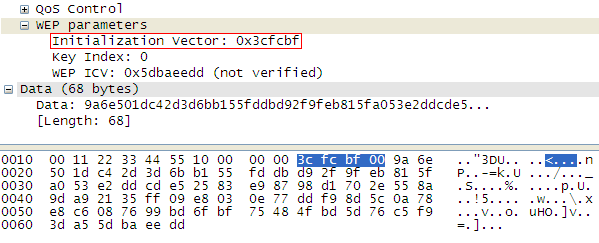
将报文以十六进制显示,红色表示加密部分
0010 00 11 22 33 44 55 10 00 00 00 3C FC BF 00 9A 6E
0020 50 1D C4 2D 3D 6B B1 55 FD DB D9 2F 9F EB 81 5F
0030 A0 53 E2 DD CD E5 25 83 E9 87 98 D1 70 2E 55 8A
0040 9D A9 21 35 FF 09 E8 03 0E 77 DD F9 8D 5C 0A 78
0050 E8 C6 08 76 99 BD 6F BF 75 48 4F BD 5D 76 C5 F9
0060 3D A5 5D BA EE DD
具体加密过程见下图 -- 引用自 Wikipedia(加上评注)
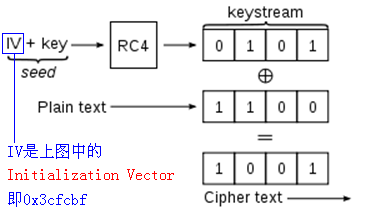
上图说明,将报文中的 Initialization Vector 字段和 WEP 密钥(连接后)作为 RC4 算法的密钥种子,生成密钥码流,再逐个与明文异或,就得到密文
现在已知报文密钥,剩下就是利用工具对其解密得到明文—这里我们继续利用 OpenSSL
OpenSSL 的 enc 命令支持 rc4 算法,其 -K 选项后跟 RC4 密钥种子,对应上图中的 seed
不过在使用前,需要改动一点代码,因为 enc 命令强制使用固定长度的 seed(实际 RC4 允许变长的 seed),具体为
rc4 128 bit
rc4-40 40 bit
如果 -K 选项指定的 seed 长度不足,则会用零补齐,凑够固定长度,如下
如果 seed 超出固定长度,则截短为固定长度
以上使用 -P 选项打印实际的 key(其实是 seed)
这里 RC4 密钥种子为 Initialization Vector||WEP Key = 0x3cfcbf3132333435,为 64 位,会被补零,造成解密错误
怎么改呢?只要修改文件 crypto\evp\e_rc4.c,如下,将 EVP_CIPHER_CTX_key_length(ctx) 改为 strlen(key)
需要指出,这只是临时的 Workaround,它会影响 -k(小写) 选项:OpenSSL 内部会先调用 EVP_BytesToKey 函数进行 Key Derivation
随后在 rc4_init_key 函数中,RC4_set_key 的入参会发生变化。感兴趣可以调试跟踪一下
顺带说下,EVP_BytesToKey 不兼容标准的 PBKDF2(参见 RFC2898)
运行修改版本的 OpenSSL
wep_cipher.txt 文件内容如下
00000000h: 9A 6E 50 1D C4 2D 3D 6B B1 55 FD DB D9 2F 9F EB
00000010h: 81 5F A0 53 E2 DD CD E5 25 83 E9 87 98 D1 70 2E
00000020h: 55 8A 9D A9 21 35 FF 09 E8 03 0E 77 DD F9 8D 5C
00000030h: 0A 78 E8 C6 08 76 99 BD 6F BF 75 48 4F BD 5D 76
00000040h: C5 F9 3D A5 5D BA EE DD
wep_plain.txt 文件内容如下
00000000h: AA AA 03 00 00 00 08 00 45 00 00 3C 7A 8C 00 00
00000010h: 80 01 3C CC C0 A8 01 16 C0 A8 01 02 00 00 86 56
00000020h: 02 00 CD 05 61 62 63 64 65 66 67 68 69 6A 6B 6C
00000030h: 6D 6E 6F 70 71 72 73 74 75 76 77 61 62 63 64 65
00000040h: 66 67 68 69 42 74 BA 61
究竟明文是什么报文呢?我们可以使用 wireshark(本例为版本 1.8.6)查看,前提是添加解密密钥,如下
菜单【Edit】-->【Preferences】,选 IEEE 802.11 --> Edit
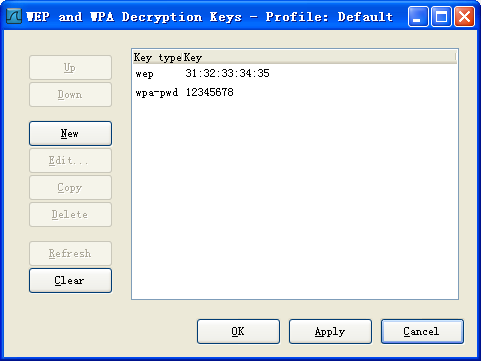
原来是 ICMP ping 报文
有两个地方需要注意
1、wireshark 显示明文长度为 68 字节,少了 wep_plain.txt 后面的 4 个字节(见上面蓝色4字节),原因是 WEP 使用 CRC32 来校验明文的完整性
实际上 CRC 结果是明文的一部分,只是没有显示在解密窗口中
可以利用 perl 自带的 crc32.bat 脚本(位于 perl\bin 目录)进行验证,命令结果为 61ba7442(字节序恰好与 42 74 BA 61 相反)
2、在IP层下方还有一层 Logical-Link Control,与常见的以太报文相比,这是 WiFi 报文的特殊之处
另外,较新版本(>=1.8.6)的 wiresharek 提供了工程文件 wireshark.vcproj,这样就可以直接在 VC 中进行编译、调试
最后考虑一下 WEP 的安全性,这里用 4 个字母缩写表示主要考虑的安全指标:SCIA,后续对安全协议将使用这些指标进行衡量,解释如下
Signature —— 签名(即对方不能否认发出的消息)
Confidentiality —— 机密(数据被加密)
Integrality —— 完整(加密数据解密后,可以知道是否受到有意无意的损坏)
Authentication —— 认证(能够识别对方的真实身份)
其他还有一些安全指标,比如授权、可用/可靠性、行为审计等,不再考虑,本文聚焦在密码学意义上的安全指标
WEP 提供了数据的机密和完整性保证,由于是对称算法,原则上无法识别对方身份(一个 AP 通常由多个无线终端共享一个 WEP 密钥接入,无法区分谁是谁),不可否认也谈不上。(事实上 WEP 是有认证之说的,分为 Open System 和 Shared Key 两种,但都不符合前面提到的强认证,即识别对方的真实身份)
我们要记住的是,WEP 已经不安全了(现在已经有诸多针对它的攻击工具,参见http://www.backtrack-linux.org/),尽量不要使用,
应该使用更安全的 wpa/wpa2/wpa-psk/wpa2-psk 方式
为什么不安全,由于涉及广泛,一篇文章无法覆盖完全,本文不再说明。
引用 http://www.cnblogs.com/efzju/archive/2013/06/12/3018661.html
